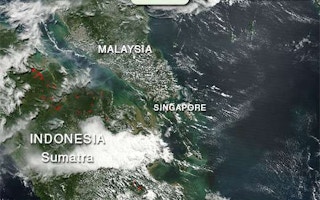It provides a platform to identify companies that are using fire to clear land, but the haze monitoring system is not “preventive” against future fires, nor is it enough to tackle wider social and economic challenges standing in the way of sustainable development.
This was the take of environmentalists and academics yesterday at a roundtable organised by the Singapore Institute of International Affairs (SIIA) which brought together 30 representatives from universities and non-government organisations (NGOs) from Singapore, Indonesia and Malaysia.
The system, developed by Singapore, was adopted for use by the three haze-hit countries as well as Brunei and Thailand last month at the ASEAN Summit. It will feature satellite images of hot spots overlaid with concession and land use maps.
Monitoring deforestation is more important than monitoring the haze, argued Greenpeace’s Forest Campaign head Bustar Maitar. It is crucial to track deforested areas and zones where development should not take place, he said. “I think the discussion here should not be only … about solving the haze but how to solve deforestation in the region — how to stop people or corporations or banks from preparing ‘fuel’ for every year’s forest fires.”
SIIA Chairman Simon Tay acknowledged that, while it is not enough “on its own”, the haze monitoring system helps to identify other steps forward, such as inter-governmental cooperation and the need for better spatial planning. It could also spur companies to act responsibly, he said.
Mr Bustar and Mr Abetnego Tarigan, Friends of the Earth Indonesia’s (WALHI) National Executive Director, told TODAY the Indonesian public, in general, is not aware of the haze monitoring system. Mr Tarigan said he himself was unsure what data the system would contain and how it would work.
Then there are the practical constraints. Official maps from Indonesian government agencies may not be able to clearly define parties responsible for fires, said the World Resources Institute’s (WRI) forest and landscape restoration Outreach Officer, Mr Andika Putraditama.
Indonesia’s One Map initiative to integrate various land use maps still has some way to go. Maps provided to the WRI by companies are “much better”, but they need to be verified through checks on the ground, he said.
The need for more science, data and better policies was also discussed at yesterday’s roundtable. Data on the health and socio-economic cost of the haze are lacking, as is the science behind some policies, according to some participants.
The scientific basis behind the threshold figure of 3 metres for the ban on development of peatland to kick in is unclear, for instance, said Universiti Malaya Senior Lecturer Helena Varkkey. “The real problem now is policy that comes before science.”
Indonesian climate and sustainability specialist Fitrian Ardiansyah noted the paltry funds dedicated to conservation — he has found that less than 1 per cent of budgets at the local district level in Indonesia are allocated to environmental protection. He also said he would like to see more collaborations among NGOs and their representatives could try to spark “change from within” by perhaps running in elections.
A Chairman’s Statement on Haze and Sustainability from the roundtable will be disseminated by NGO Roundtable participants to relevant ministries in their own countries. Prof Tay said the SIIA will be looking to hold another multi-sector dialogue on sustainable resources from the Association of Southeast Asian Nations.










